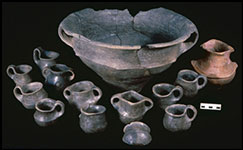Crossref Citations
This article has been cited by the following publications. This list is generated based on data provided by
Crossref.
Quinn, Colin P.
Ciugudean, Horia
and
Beck, Jess
2020.
The politics of placing the dead in Bronze Age Transylvania.
Journal of Archaeological Science: Reports,
Vol. 34,
Issue. ,
p.
102574.
Duffy, Paul R.
and
Biehl, Peter F.
2020.
River networks and funerary metal in the Bronze Age of the Carpathian Basin.
PLOS ONE,
Vol. 15,
Issue. 9,
p.
e0238526.
DiNapoli, Robert J.
Rieth, Timothy M.
Lipo, Carl P.
and
Hunt, Terry L.
2020.
A model-based approach to the tempo of “collapse”: The case of Rapa Nui (Easter Island).
Journal of Archaeological Science,
Vol. 116,
Issue. ,
p.
105094.
Quinn, Colin P.
and
Fivenson, Daniel
2020.
Transforming Legacy Spatial Data into Testable Hypotheses about Socioeconomic Organization.
Advances in Archaeological Practice,
Vol. 8,
Issue. 1,
p.
65.
Staniuk, Robert
2021.
EARLY AND MIDDLE BRONZE AGE CHRONOLOGY OF THE CARPATHIAN BASIN REVISITED: QUESTIONS ANSWERED OR PERSISTENT CHALLENGES?.
Radiocarbon,
Vol. 63,
Issue. 5,
p.
1525.
Jaeger, Mateusz
Kulcsár, Gabriella
Melis, Eszter
Stróżyk, Mateusz
Piszora, Paweł
Csányi , Marietta
Csuvár-Andrási, Réka
Fischl, Klára P.
Guba, Szilvia
Pap, Evelin
Pásztor , Emília
Patay, Róbert
Szathmári , Ildikó
Szilas, Gábor
Čivilytė, Agnė
and
Kiss, Viktoria
2023.
Baltic Amber in Hungarian Bronze Age. New data and current stage of research.
Sprawozdania Archeologiczne,
Vol. 75,
Issue. 2,
p.
137.
DARÓCZI, TIBOR-TAMÁS
BĂLĂRIE, ANDREI
OLSEN, JESPER
and
BIRCLIN, MIROSLAV
2023.
Banatian DeathMetals: Radiocarbon Dating of Cremation Burials of the Setting Bronze Age and Dawning Iron Age.
Proceedings of the Prehistoric Society,
Vol. 89,
Issue. ,
p.
157.
Molloy, Barry
Jovanović, Dragan
Bruyere, Caroline
Estanqueiro, Marta
Birclin, Miroslav
Milašinović, Lidija
Šalamon, Aleksandar
Penezić, Kristina
Ramsey, Christopher Bronk
Grosman, Darja
and
Gimatzidis, Stefanos
2023.
Resilience, innovation and collapse of settlement networks in later Bronze Age Europe: New survey data from the southern Carpathian Basin.
PLOS ONE,
Vol. 18,
Issue. 11,
p.
e0288750.
Molloy, Barry
2023.
Was There a 3.2 ka Crisis in Europe? A Critical Comparison of Climatic, Environmental, and Archaeological Evidence for Radical Change during the Bronze Age–Iron Age Transition.
Journal of Archaeological Research,
Vol. 31,
Issue. 3,
p.
331.
Parditka, Györgyi
and
Duffy, Paul R.
2023.
From the ashes of Bronze Age fires: A framework for comparison across body treatments.
Journal of Anthropological Archaeology,
Vol. 71,
Issue. ,
p.
101525.
Orfanou, V.
Amicone, S.
Sava, V.
O’Neill, B.
Brown, L. E. F.
Bruyère, C.
and
Molloy, B. P. C.
2023.
Forging a New World Order? Interdisciplinary Perspectives on the Management of Metalworking and Ideological Change in the Late Bronze Age Carpathian Basin.
Journal of Archaeological Method and Theory,
Vol. 30,
Issue. 2,
p.
565.
Bruyère, Caroline
Daly, J. Stephen
van Acken, David
Jovanović, Dragan
Orfanou, Vana
Franković, Filip
Spasić, Miloš
Koledin, Jovan
and
Molloy, Barry
2024.
Trade, recycling and mixing in local metal management strategies of the later Bronze Age south Carpathian Basin: Lead isotope and chemical analyses of hoarded metalwork.
Journal of Archaeological Science,
Vol. 164,
Issue. ,
p.
105957.
Krečković-Gavrilović, M
Radinović, M
Porčić, M
Pendić, J
Milašinović, L
and
Stefanović, S
2025.
Absolute chronology and spatial organization of the Early Bronze Age necropolis in Mokrin.
Radiocarbon,
Vol. 67,
Issue. 2,
p.
318.
